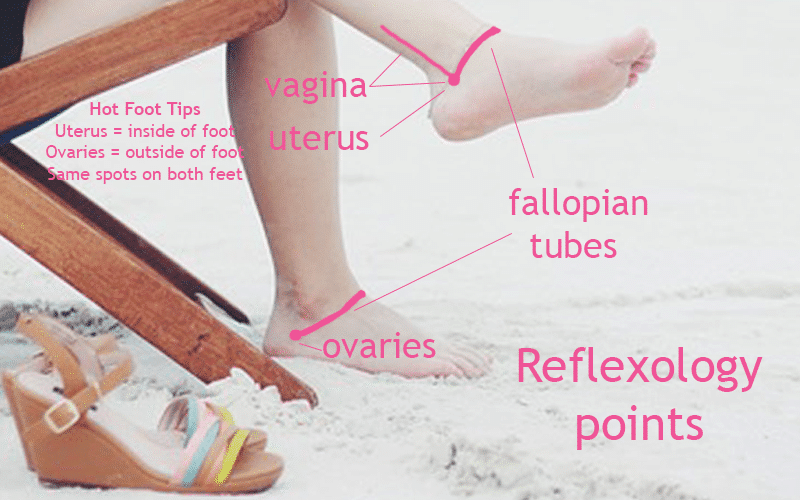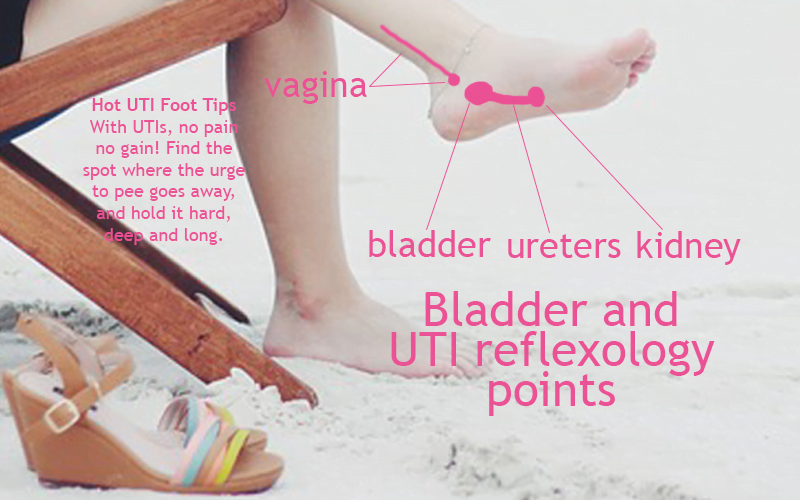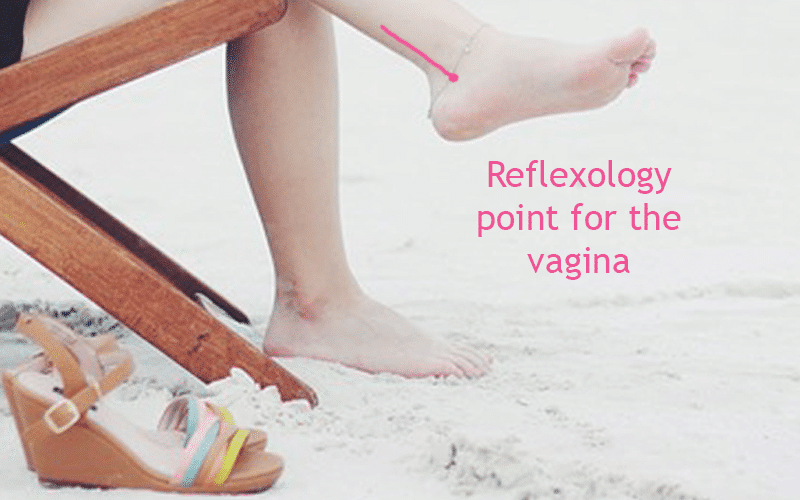Reflexology for vaginal and pelvic problems
Reflexology is the use of pressure points on the feet, hands and ears that effects change in the body. We’re not exactly sure how this works, but you can read more on some theories on how it works.
There are quite a few conditions that can be relieved either partially or fully, temporarily or permanently, using reflexology. 1,2
Each person and body is different, so the effects will vary depending on the person, and also who is performing the reflexology. There is a knack to do it well, but luckily for us, it’s pretty easy to do yourself at home.
Why focusing on just one area of your body can be complicated
The basics of general reflexology can be found in abundance online, so here we just focus on pelvic problems. It’s not always right to focus on just one area of the body with reflexology, because the problem could really be stemming from another area, so understanding a bit about what’s happening to you is important.
A good example of this would be blood sugar problems (pre-diabetes, metabolic syndrome, insulin resistance) that results in recurrent yeast infections. In this case treating the vagina will not really solve the problem – which could be a diet problem, a pancreas problem, or an insulin problem – but treating your vagina may provide some temporary relief.
This is because the reflexology treatment boosts your vaginal cells to defend themselves and may provide temporary pain relief, and this can relieve the uncomfortable symptoms of a yeast infection like itching or pain.
If you have pelvic floor tension, reflexology can offer support to your muscles, ligaments and tendons, relieving tension and the subsequent pain.
You are likely to need multiple treatments to get the best effect, and to get treatments for your whole body. Your pelvic floor muscles do not exist in a vacuum – they are connected to every other part of you, and the rest of you matters.
What’s magical about reflexology is that it works on all your body parts to send them what they need to repair and help prevent pain, and it does it quickly.
What you can treat with reflexology
You can treat any area of the body with reflexology, whether it is sore, itchy, cramping, or feels fine.
You can think of reflexology as sending a bolt of energy (imagine electricity if you want to) through your body, clearing a pathway, clearing out debris, loosening tightness, and tightening looseness.
The pelvis holds a lot, and it can be tricky to find some of the pressure points for the pelvic structures, since the area of the foot that contains those pressure points has a lot of nooks and crannies. 3
Issues that reflexology can help with: 4,5
- Vulvovaginal infections
- Urinary tract infections
- Period pain
- Infertility
- Hormone issues
- Pelvic floor tension and associated conditions
- Vulvodynia
- Vaginal and vulvar pain
- Vulvovaginal wound healing and pain management, for example after a vaginal birth, surgery or trauma
- Just about any vulvar or vaginal problem
What reflexology cannot help with
Reflexology is a fantastic tool, but it’s not magic. Reflexology cannot cure any disease, and it shouldn’t be used in that way. Reflexology may have some miraculous recoveries behind it, but that is an individual responding in their own way to the treatments.
“Curing” a vulvovaginal, pelvic or reproductive problem is likely to need a multi-pronged approach, not just one set of treatments. That being said, if reflexology is all you have, you can sure try.
Reflexology cannot alter your tissue, so for example you cannot correct an anatomical abnormality or shrink your labia. What you can do is support healing and offer some relaxation and pain relief.
How to do reflexology
To do reflexology on yourself, you will need a working thumb and to be able to reach your feet.
You can also do reflexology on your hands and ears, however in this case we just use the feet because they are nice and big. You need to be gentle to find the points – they can be very tricky to find.
Often they are up, under, and a little bit hidden. Finding them means pushing firmly but gently until you find the area that is tender – this is your spot.
Then, push firmly but gently on the spot, for 30 seconds, then release. Repeat this sequence on all relevant pressure points for your health condition.
How do I know which points to press?
Understanding which pressure points to poke on for your health condition can be hard, but just think about the nature of your problem to help figure it out. Look it up if you have to.
Examples of what needs pressing for specific health condition:
- A urinary tract infection – treat bladder, ureters and kidney
- Vulvodynia – treat whole pelvic area, vagina, sciatic nerve, uterus, ovaries, fallopian tubes


Reflexology on children
Using the feet to treat moderate to minor conditions in a child’s vagina, vulva or pelvis can be safely performed by a parent or caregiver. 6
Kids love getting their feet rubbed so long as you’re nice about it, so be gentle and make it feel good. You don’t need to push very hard on a kid’s foot – they are very responsive to pressure point therapy, and you don’t want to scare them off.
Butter them up with delicious foot rubs all the time, and they’ll be much more receptive to tiny amounts of harder pressure or tender spots once they understand that it helps them feel better.
They’ll also learn when you’re ‘on the spot’, and when you are missing it, because they’ll be able to tell you once they have the language skills for it. This feedback is invaluable.
References
- 1.Bianco G. Fascial neuromodulation: an emerging concept linking acupuncture, fasciology, osteopathy and neuroscience. Eur J Transl Myol. Published online August 27, 2019. doi:10.4081/ejtm.2019.8331
- 2.Labat JJ, Delavierre D, Sibert L, Rigaud J. Explorations électrophysiologiques des douleurs pelvipérinéales chroniques. Progrès en Urologie. Published online November 2010:905-910. doi:10.1016/j.purol.2010.08.061
- 3.Bai Y, Wang J, Wu J peng, et al. Review of Evidence Suggesting That the Fascia Network Could Be the Anatomical Basis for Acupoints and Meridians in the Human Body. Evidence-Based Complementary and Alternative Medicine. Published online 2011:1-6. doi:10.1155/2011/260510
- 4.Sharifi N, Bahri N, Hadizadeh-Talasaz F, Azizi H, Nezami H, Tohidinik HR. A randomized clinical trial on the effect of foot reflexology performed in the fourth stage of labor on uterine afterpain . BMC Pregnancy Childbirth. Published online January 21, 2022. doi:10.1186/s12884-022-04376-w
- 5.Yousefi F, Hafizi L, Razmjoo N, Azizi H. The effect of complementary medicine on maternal health promotion: An experimental study. J Edu Health Promot. Published online 2021:26. doi:10.4103/jehp.jehp_961_20
- 6.Karatas N, Dalgic AI. Effects of reflexology on child health: A systematic review. Complementary Therapies in Medicine. Published online May 2020:102364. doi:10.1016/j.ctim.2020.102364






